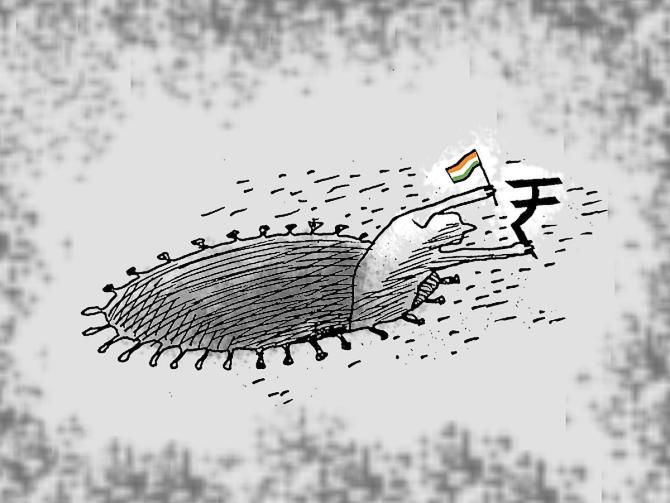Claims of a spike in poverty and inequality in India during the Covid-19 pandemic are patently false as such claims are based on uncomparable different surveys, according to a paper co-authored by eminent economist Arvind Panagariya.

The paper also noted that inequality fell in the country during Covid years, both in rural and urban areas as well as nationally.
Panagariya, Columbia University Professor and former vice chairman of NITI Aayog and Vishal More of Intelink Advisors, New Delhi have co-authored a detailed paper 'Poverty and Inequality in India: Before and After Covid-19'.
The paper will be presented at a forthcoming conference on the Indian Economy at Columbia University organised by the Deepak and Neera Raj Center on Indian Economic Policy at Columbia University's School of International and Public Affairs.
The paper analyses poverty and inequality before and after the Covid-19 pandemic in India using data on household expenditures reported in the periodic Labour Force Survey (PLFS) conducted by the National Statistical Office (NSO) of India.
The main findings of the paper say that poverty levels derived from the periodic Labour Force Survey (PLFS) are not comparable to those derived from Consumer Expenditure Surveys (CESs) conducted in 2011-12 and earlier due to differences in sample design.
"Claims of increase in poverty in 2017-18 based on a comparison of estimates derived from the CES in 2011-12 and the PLFS in 2017-18 or later must be rejected," the paper says.
Sample designs of PLFS and CES are vastly different, it said.
The findings also state that on a quarterly basis, rural poverty rose marginally in the strict lockdown quarter (April-June 2020) but fell below the pre-Covid-19 level soon after and continued to decline.
On an annual basis, inequality fell during the post-Covid-19 era in both rural and urban areas and in rural and urban areas combined.
Overall, "claims of massive increases in poverty and inequality during Covid-19 are patently false," the paper's findings said.
"On an annual basis, poverty continued to fall in rural areas during the Covid year of 2019-20 albeit at a significantly lower rate.
"Rural poverty saw the same sharp decline in 2020-21 as in the pre-Covid year of 2018-19," it said.
"On the quarterly basis, rural poverty saw a modest rise only during the strict lockdown quarter of April-June 2020," the paper said, adding that these results are consistent with the robust performance of agriculture in 2019-20 and 2020-21.
The paper also notes that urban poverty saw a modest rise on an annual basis in 2020-21.
On a quarterly basis as well, it saw only a modest rise though it lasted for four quarters beginning with the strict lockdown quarter of April-June 2020.
"But by April-June 2021 quarter, the decline in urban poverty had resumed.
"While the rise in urban poverty for four quarters was consistent with the large decline in the production of contact-intensive industries, free distribution of additional 5 kg food grain perhaps helped arrest the sharper decline in urban poverty," it said.
In the paper, Panagariya and More analyse and offer a critique of some existing studies that reached the conclusion that Covid-19 led to a widespread increase in poverty.
One of the studies the paper critiques is the Azim Premji University Report (2021) based on the household income and expenditure survey, namely, Consumer Pyramids Household Survey (CHPS) conducted by the Center for Monitoring Indian Economy (CMIE).
The paper notes that the Azim Premji University study found massive employment losses, an increase in rural, urban and overall poverty and an increase in rural, urban and overall inequality.
In its criticism of this study, the paper by Panagariya and More notes that “rather than measure poverty and inequality directly from the expenditure survey, the report invents an event study to measure them. This is odd and suspect and we do not find it at all persuasive.”
In its concluding remarks, the paper said “there remains a widespread belief that Covid-19 resulted in a massive increase in poverty in India.
"But this observation sits awkwardly against the facts that the poor in India reside disproportionately in rural areas; they are heavily dependent on agriculture; agriculture showed no deviation from its trend in earlier years and exhibited healthy growth throughout the Covid-19 era; and the government was quick to double down on its anti-poverty initiatives soon after the onset of Covid-19."
It said these factors suggest that there ought to be no perceptible rise in rural poverty.
The '3rd Columbia Summit on The Indian Economy' will be held March 24-25 and will be addressed by IMF Executive Director Krishnamurthy Subramanian, Secretary in the Ministry of Health & Family Welfare Rajesh Bhushan, Secretary, Department for Promotion of Industry and Internal Trade Anurag Jain, former US Ambassadors to India Kenneth Juster and Frank Wisner, India's Consul General in New York Randhir Jaiswal and NCAER Director General Poonam Gupta among other eminent members from the field of academia, economics and policy.










